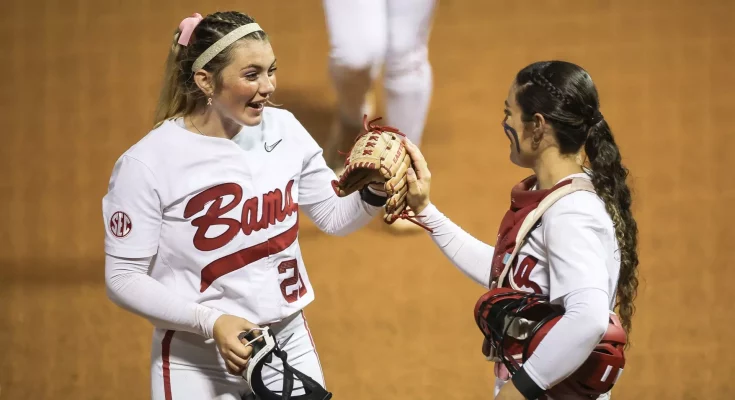Alabama’s football legacy is a narrative few programs can rival, a story written through decades of dominance, forged in the heat of battle, and defined by figures whose names resonate with immortality in Tuscaloosa and beyond. In 2025, that story has taken on an electrifying new chapter. In a stunning and unprecedented development, a wave of former Crimson Tide greats—icons like Nick Saban, Jalen Hurts, Derrick Henry, and others—have converged once more upon Alabama’s campus. Their collective mission is clear: to rekindle the championship spark, restore dominance, and bring the Crimson Tide roaring back to the summit of college football. This isn’t just a symbolic reunion or a feel-good homecoming. It’s a calculated, coordinated, and deeply strategic power play that may very well shift the axis of college football itself.
After a couple of relatively quiet seasons by Alabama’s sky-high standards—where playoff appearances were no longer guaranteed and other SEC programs like Georgia and LSU seized the spotlight—there was a growing sense among Tide loyalists that something had to change. Though new head coach Kalen DeBoer made solid inroads with player development and offensive innovation, the program lacked that unmistakable aura of invincibility it once possessed. So when whispers began circulating earlier this summer that Nick Saban, the architect of Alabama’s dynastic run, was returning in an advisory role, the entire college football world held its breath. And then came the flood. Not long after Saban’s announcement, Heisman winner Derrick Henry, Super Bowl quarterback Jalen Hurts, and a rotating cast of Alabama legends began making their presence felt in spring workouts, team meetings, and community engagements.
Their return is not ceremonial. It’s tactical. Nick Saban, now serving as Executive Advisor of Athletic Excellence and Development, may no longer pace the sidelines in a headset, but his fingerprints are already everywhere. From instilling mental discipline in practice to consulting on recruiting strategies, his insights offer invaluable perspective. Saban’s deep institutional knowledge, his eye for potential, and his relentless focus on “The Process” are seeping back into the Crimson Tide’s organizational DNA. His collaboration with Coach DeBoer has reportedly been seamless, forming a rare fusion of Saban’s structural genius and DeBoer’s schematic flexibility. For players, having Saban present—even in a non-coaching role—immediately raises the bar. His very presence commands accountability, and that is rippling through the locker room like a voltage current.
If Saban’s presence brings back the mind of the dynasty, then Jalen Hurts and Derrick Henry bring back its heart and soul. Both men embody the resilience, toughness, and leadership Alabama is synonymous with. Hurts, fresh off a Pro Bowl season with the Philadelphia Eagles, has returned to Tuscaloosa during the NFL offseason to work with quarterbacks and speak to the team regularly. His journey—from being benched for Tua Tagovailoa to transferring to Oklahoma to becoming one of the NFL’s top QBs—is a testament to perseverance. Young Tide quarterbacks hang on his every word, and Hurts’ film room breakdowns have become legendary already. His presence offers a powerful example of emotional maturity, situational awareness, and game-day poise.
Derrick Henry, meanwhile, remains a juggernaut in the NFL with the Baltimore Ravens, but his deep ties to Alabama have always remained strong. His off-season training is already the stuff of myth, and now he’s channeling that work ethic into mentoring Alabama’s current stable of running backs. Henry hasn’t just been dropping in for motivational speeches—he’s actively helping with drills, teaching techniques, and explaining how to read linebacker stances to maximize rushing angles. For Alabama’s young backs, absorbing knowledge from Henry is like learning swordplay from a grandmaster. Few athletes in college football or the pros command such respect through physicality and preparation.
It’s not just Hurts and Henry either. Amari Cooper has been spotted running routes and hosting receiving clinics for young Tide wideouts. Minkah Fitzpatrick and Marlon Humphrey, two of the NFL’s top defensive backs, have been present for defensive backfield meetings, offering technical insight into footwork, leverage, and coverage schemes. Even Tua Tagovailoa, known more for his soft-spoken demeanor, has offered spiritual guidance and clarity on how to handle pressure, expectations, and adversity. There’s even word that Julio Jones and Dont’a Hightower, two titans of the Saban era, have taken interest in appearing during fall camp to further deepen the reservoir of wisdom available to current players.
This all adds up to more than just nostalgia. It’s a new competitive advantage in the NIL era—an era where programs are judged as much on their professional pipelines as on their on-field results. For a recruit, the pitch is irresistible: come to Alabama, and you won’t just be coached by current staff—you’ll be mentored by legends. You’ll train alongside the people you grew up watching on Sundays. You’ll be part of something generational. That proposition is powerful, and it’s already paying dividends. Alabama’s 2026 recruiting class, once lagging behind the likes of Ohio State, Texas, and Georgia, is now surging. Elite blue-chip players have begun committing at an accelerated pace, citing the “culture” and “legacy” that the returning legends represent.
The atmosphere around the Alabama program feels recharged. Practices are sharper, weight room sessions more intense, and the locker room chatter more focused. There’s a new layer of professionalism permeating every aspect of the program. Defensive players are spending extra hours watching NFL tape provided by Fitzpatrick and Hightower. Offensive linemen are studying Alex Leatherwood’s blocking techniques via Zoom. Quarterbacks are running seven-on-sevens with a Hurts playbook from the Eagles. It’s as if Alabama’s past, present, and future have collapsed into one hyper-efficient machine.
Of course, none of this guarantees a national title. The SEC is still a battlefield. Georgia isn’t going anywhere. LSU, Texas, and Ole Miss all pose significant threats. But what Alabama has now is something those other programs can’t replicate: a brotherhood that extends beyond rosters and depth charts. A lineage of greatness that shows up in person, rolls up its sleeves, and goes to work. It’s cultural osmosis at the highest level, and it may be the X-factor Alabama has been missing since Saban’s retirement.
Critics will question how sustainable this model is. Can Alabama really rely on NFL stars to drop in year after year? Won’t it eventually become a distraction or diminish the authority of the current coaching staff? So far, all signs suggest the opposite. Coach DeBoer has embraced the input and found ways to align it with his systems. The returning stars have respected boundaries, often working behind the scenes rather than in the spotlight. Most importantly, the players themselves have responded. There is a renewed hunger, a refusal to settle, a sense that the eyes of giants are watching.
And then there’s the fan base. Crimson Tide Nation, known for its fervor and tradition, is experiencing a renaissance of its own. Season ticket sales have skyrocketed. Social media engagement is off the charts. Alumni donations are flowing in at a record pace. And Bryant-Denny Stadium? It’s poised to become a fortress once more. The upcoming season opener already has the feel of a revival meeting—where football, faith, and family converge under those familiar Saturday lights.
Ultimately, Alabama’s legendary power play isn’t about simply returning to former glory—it’s about evolving it. It’s a new model for excellence, one that blends historical pride with modern execution. A program that once stood atop the mountain because of its coaching acumen and elite recruiting is now doubling down on generational mentorship. What we are witnessing may very well be the start of something larger than football—a case study in legacy, leadership, and loyalty. Because when Saban, Hurts, Henry, and company walk back into the halls of the Mal Moore Athletic Facility, they’re not just coming home. They’re lighting a fire. And the rest of college football better



